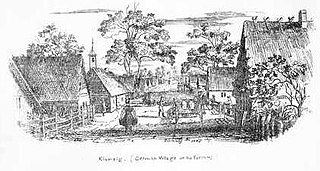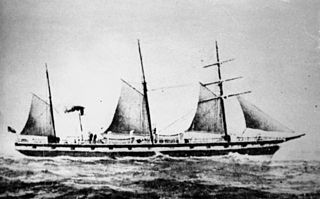Related Research Articles

German settlement in Australia began in large numbers in 1838, with the arrival of immigrants from Prussia to Adelaide, in the then colony of South Australia. German immigrants became prominent in settling South Australia and Queensland. From 1850 until World War I, German settlers and their descendants comprised the largest non-British or Irish group of Europeans in Australia.

Forfarshire was a paddle steamer with brigantine rigging, built in Dundee in 1834, and which struck and later foundered on one of the Farne Islands on 7 September 1838, giving rise to the rescue for which Grace Darling is famed.

SS Gothenburg was an iron-hulled sail- and steamship that was built in England in 1854 and sailed between England and Sweden until 1862. She then moved to Australia, where she operated across the Tasman Sea to and from New Zealand until 1873, when she was rebuilt. After her rebuild, she operated in the Australian coastal trade.
The Kingstown lifeboat disaster occurred on Christmas Eve 1895 off Kingstown, Ireland, when the Kingstown lifeboat was capsized while attempting to rescue the crew of the stricken SS Palme. The crew of fifteen were lost. The event is commemorated annually at Dún Laoghaire Harbour.

Elizabeth Reef, located at 29°57′25″S159°4′32″E, is a coral reef in the Coral Sea. The reef is separated by a deep oceanic pass, some 47 km wide, from nearby Middleton Reef, both of which are part of the underwater plateau known as the Lord Howe Rise. It is around 150 km from Lord Howe Island and 600 km from the New South Wales coast of Australia. The Environment, Sport and Territories Legislation Amendment Act 1997 included Elizabeth Reef in Australia's Coral Sea Islands Territory.

The Adelphoi was a wooden barque built in Sunderland, UK, that spent most of her working life in Australian waters. She was wrecked off Port Hacking, Australia, in 1879.

Alf was a three-masted Norwegian barque which became stranded and then wrecked on 23 November 1909 on Haisbro Sands, off the coast of Norfolk. She was originally built in 1876 as Inchgreen for Scottish owners. In the 1890s she was sold to Danish owners and renamed Adolph Harboe. Around the turn of the 20th century she was sold to Norwegian owners and renamed Alf, serving until she was wrecked off the coast of Norfolk.

Comet was an 1851 California clipper built by William H. Webb which sailed in the Australia trade and the tea trade. This extreme clipper was very fast. She had record passages on two different routes: New York City to San Francisco, and Liverpool to Hong Kong, and beat the famous clipper Flying Dutchman in an 1853 race around the Horn to San Francisco.

The Queen Bee was a ship, constructed in Sunderland and launched in 1859. It was used primarily for transporting immigrants from England to New Zealand, having made about 11 journeys before grounding on Farewell Spit in 1877.
Marchioness was a brigantine built at Waterford, Ireland in 1851 and registered at Melbourne that sailed between Nelson, New Zealand and Melbourne, Australia in the 1850s. It foundered on rocks off the Taranaki coast in 1864 and was lost with no loss of life, having previously grounded twice, once off the coast of Victoria, Australia, and once in Cook Strait.
Loch Bredan was a British sailing ship built in Glasgow in 1882 which disappeared without trace with all hands around November 1903.

Lady Kinnaird was a three masted barque which was built in 1877 at Dundee, Scotland by Brown & Simpson for W.B. Ritchie. She operated between the United Kingdom and the Australian colonies. She was lost after running aground in Spencer Gulf south of Cape Burr on the east coast of Eyre Peninsula in South Australia early on 21 January 1880. Her main anchor was recovered from her wreck site in 1979 and was placed on display in the nearby town of Port Neill in January 1880 as part of the commemoration of the centenary of her loss.
Pestonjee Bomanjee was a wooden sailing ship built in 1834 by James Lang of Dumbarton, Scotland. She was a three-masted wooden barque of 595 tons, 130 feet in length, 31.5 feet in breadth, first owned by John Miller Jnr and Company, Glasgow. Her last-known registered owner in 1861 was Patrick Keith & George Ross, Calcutta, India.
Rapid was a brig launched in 1821 or 1826 at Yarmouth. In 1836 she brought William Light's surveying party to the new colony of South Australia. She was wrecked in 1841.
Libelle was a 650-ton iron-hulled barque, built in the Free City of Bremen in 1864. The ship was transporting quicksilver and passengers when she wrecked on the eastern reef of Wake Island in 1866. After three weeks they set out in a longboat and Gig they sailed to Guam, with only 22 in the longboat making it. In the years that followed many made expeditions to search cargo of the Libelle, to make dives to recover the quicksilver flasks. The anchor remains on Peale island, and was rediscovered in the 1930s when Wake became seaplane port with a hotel.

The New Zealand Company was a 19th-century English company that played a key role in the colonisation of New Zealand. The company was formed to carry out the principles of systematic colonisation devised by Edward Gibbon Wakefield, who envisaged the creation of a new-model English society in the southern hemisphere. Under Wakefield's model, the colony would attract capitalists who would then have a ready supply of labour—migrant labourers who could not initially afford to be property owners, but who would have the expectation of one day buying land with their savings.
John Ralph Hansford Ward, invariably known as Hansford Ward or Captain Ward, was a ship's captain in South Australia, who figures prominently in the pre-history of the Adelaide Steamship Company. A son, also named John Ralph Hansford Ward but known as John R. H. Ward, was also a ship's captain.
The Kalara was an iron paddle steamer built in 1881 by Smith, Forrester, and Co., and launched at Kangaroo Point for Messrs. D. L. Brown and Co. It ran regular trips between Brisbane and the Tweed River. On Saturday 6 November 1886 the Kalara whist exiting the tweed river ran over its own anchor and pierced its hull causing it to sink approximately 30 minutes later approximately one mile north-east of Point Danger and from the Tweed River bar in 15 fathoms.
References
- 1 2 "First Wreck at the Port". The Observer . Adelaide. 17 June 1916. p. 30. Retrieved 2 February 2016– via National Library of Australia.
- ↑ "Loss of the Barque "Grecian"". South Australian Register . Adelaide. 15 October 1850. p. 2. Retrieved 2 February 2016– via National Library of Australia.
- ↑ On her beam-ends: (nautical) heeled over so far that the deck is practically vertical